Mauritia flexuosa
| moriche palm | |
|---|---|
 | |
| Palma canangucha | |
| Scientific classification | |
| Kingdom: | Plantae |
| (unranked): | Angiosperms |
| (unranked): | Monocots |
| (unranked): | Commelinids |
| Order: | Arecales |
| Family: | Arecaceae |
| Genus: | Mauritia |
| Species: | M. flexuosa |
| Binomial name | |
| Mauritia flexuosa L.f. | |
| Synonyms[1] | |
| |
Mauritia flexuosa, known as the moriche palm, ité palm, ita, buriti, muriti, canangucho (Colombia), or aguaje (Peru), is a palm tree. It grows in and near swamps and other wet areas in tropical South America. It has been reported from Trinidad, Colombia, Venezuela, Guyana, Suriname, French Guinea, Brazil, Ecuador, Peru, and Bolivia.[2]
M. flexuosa, a tree, can reach up to 35 m (115 ft) in height. The large leaves form a rounded crown. The flowers are yellowish and appear from December to April. The fruit, which grows from December to June, is a chestnut color and is covered with shiny scales. The yellow flesh covers a hard, oval nut. The seeds float, and this is the means by which the palm tree propagates. In natural populations, the tree reaches very high densities.[3]
Fruit
Moriche palm fruit is edible, has a high vitamin C content, and used to make juice, jam, ice cream, and a fermented "wine". The inflorescence buds are eaten as a vegetable and the sap can be drunk fresh or fermented (see palm wine). Threads and cords are locally produced from the tree's fibers.
Oil
Buriti oil is an orange-reddish oil extracted from the fruit of the moriche palm. The oil contains high concentrations of oleic acid, tocopherols, and carotenoids, especially beta-carotene.[4] The oil has a reddish color used as ink on hides and skins.[5]
Ecology
This tree is important to many animal species; several bird species, such as the red-bellied macaw, sulphury flycatcher, and moriche oriole, use it for nesting and food. Many ungulates, fish, and monkeys depend on the fruit.[6]
Miscellaneous
The government of the Federal District - the Brazilian state where the country's capital, Brasília, is located - is called Palácio do Buriti ("Buriti Palace"). Across the street from the building is a square with fountains and a single moriche palm tree, which was taken from the outskirts of the city and replanted there. The species is a common feature of the cerrado vegetation that predominates in central Brazil.
-
-

-
.jpg)
-
-
-
-
-
-

-

Fruits
-

Moriche palm fruit, also called aguaje in Peru
-

Karajá people, cart lid "Warabahu"
References
- ↑ The Plant List Mauritia flexuosa
- ↑ Kew World Checklist of Selected Plant Families, Mauritia flexuosa
- ↑ http://horizon.documentation.ird.fr/exl-doc/pleins_textes/pleins_textes_6/b_fdi_43-44/010005452.pdf
- ↑ http://cat.inist.fr/?aModele=afficheN&cpsidt=18336612
- ↑ PESCE, Celestino. Oleaginosas da Amazonia.-Belém: Museu Paraense Emilio Goeldi, 2009. 334 p.: il. ISBN 978-85-61377-06-9 (MPEG) e 978-85-60548-39-2 (MDA)
- ↑ http://assets.wwf.ch/downloads/aguaje_wwf_peru.pdf
External links
 Media related to Mauritia flexuosa at Wikimedia Commons
Media related to Mauritia flexuosa at Wikimedia Commons